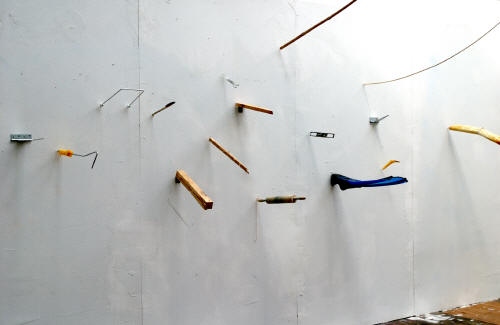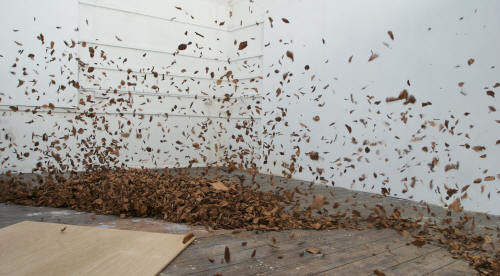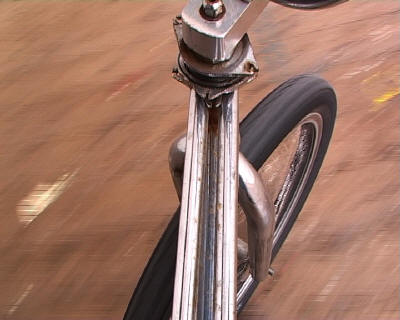|
|
| home | features | exhibitions | interviews | profiles | webprojects | gazetteer | links | archive | forum |
|
Jonty Lees Tate St Ives 5th October 2007 - 13th January 2008
There was a comparable low-tech conjuring act at the heart of a projected video of leaves being blown around Lees' studio. Called 'Untitled' (below), the work was evocative of the landscape and of the artist Giuseppe Penone. A flat board was allowed to fall with a smack, causing dry brown leaves to billow upwards, giving brief sculptural form to the resulting gust of air.
This process was repeated again and again, and spliced together on the video to create a kind of artificial autumnal weather. The fact that this was the studio used by the most eminent of the St Ives artists, Ben Nicholson and Patrick Heron, added another layer of meaning: Nicholson himself tended to prefer to use board to work on, and often used a similar palette of brown.
Push-bikes have featured a lot in Lees' work. 'Tour de studio' (below)- a title which in this context seems to refer jokily both to the Tour de France and to French art of the past - was a video playing on a monitor, made by attaching a camera to the wheel of a bike and pointing it to the floor as it meandered around the space. Less immediate than the other works it, again, acquired meaning when considered in the context of the studio in which it was made, and in the catalogue it was linked via Bruce Nauman to Duchamp's readymade of the bicycle wheel. On the floor was another monitor showing
the artist's finger as it traced an outline around all the objects in a
room and also visible through the window outside. The movement, which
had a strange obsessive intensity that was a bit like drawing, spatially
linked foreground with background. It was not clear, however, whether
The smallest and least obtrusive work was called 'Casio' (below) and was simply a lenticular postcard of a digital watch reflecting the light of the sun. When the viewer moved in-front of it, the glare appeared to grow such that the watch started glinting. The work celebrated the wonder of the everyday, and did so with extraordinary economy of means. Like the BMX bike, the emphasis placed on a familiar and nostalgic brand name, was also subtly significant. The definitive account of conceptual art, by Lucy Lippard, was called 'The dematerialisation of the art object', and in the context of St Ives, this is what was refreshing about Lees' show: the traditional art object, carefully crafted in bronze or oil-paint, had disappeared in a puff of leaves and air. However, Lees' art is still a form of sculpture: it is sculpture that moves or performs - ie it is kinetic sculpture, and it therefore relates to Roman Signer's exploding balloons and wellingtons and, going further back in time, to Gabo's vibrating wire and indeed to the mobiles of Mary and Kenneth Martin which were installed in the next door gallery.
Like the Martins, Lees' work is actually rather formal, and abstract in the sense that it doesn't really have a subject, narrative or message. Instead it excels in being non-committal, effortless and free, and in having an almost intangible lightness of touch that is a truthful response to the world as it presents itself to the senses: as 'noumena' to use Kant's term. This lightness is necessary to Lees' project because, as other phenomenologists have observed , we perceive the world most honestly when we approach it with an open mind, and without preconceptions of how it should look or be.
Lees was the fifth artist in residence at Tate St Ives. His exhibition was accompanied by a catalogue with essays by Michael Archer and Martin Clark. Rupert White 29/12/07 photographs Andy Hughes |
|
|

 There is always something thrilling about seeing
bits of rubbish given the aura of high art by being placed in a pristine
and prestigious gallery like the Tate. 'We salute you!' (right) was a bank of
woodwork tools, discarded fishing paraphernalia, and other humble objects
fixed to the wall that lifted upwards, like a small, shambolic squadron of soldiers saluting, every time someone opened the door
to the gallery. The mechanism was not elaborate, and required nothing
more than fishing line passing from the objects to the door opposite
(although it took most of the visitors a few seconds to realise this for
themselves). However, like a puppeteer, by animating previously
inanimate things the artist had given magical life to them.
There is always something thrilling about seeing
bits of rubbish given the aura of high art by being placed in a pristine
and prestigious gallery like the Tate. 'We salute you!' (right) was a bank of
woodwork tools, discarded fishing paraphernalia, and other humble objects
fixed to the wall that lifted upwards, like a small, shambolic squadron of soldiers saluting, every time someone opened the door
to the gallery. The mechanism was not elaborate, and required nothing
more than fishing line passing from the objects to the door opposite
(although it took most of the visitors a few seconds to realise this for
themselves). However, like a puppeteer, by animating previously
inanimate things the artist had given magical life to them.
 Gleaming under a spotlight adjacent to the
projection was a BMX bike, customised by the addition of artificial
hair extensions on the handles. Also untitled, this work was the most
sensual and seductive of those displayed: the hair giving the bike a
fetishistic and almost sexy quality.
Gleaming under a spotlight adjacent to the
projection was a BMX bike, customised by the addition of artificial
hair extensions on the handles. Also untitled, this work was the most
sensual and seductive of those displayed: the hair giving the bike a
fetishistic and almost sexy quality.  the
room itself which looked like a fairly typical Cornish cottage, was
significant.
the
room itself which looked like a fairly typical Cornish cottage, was
significant.